Lizard on a Rock, Double Dog, Double Plank, Shoulder Stand on Bridge Pose – are only a few partner poses that are integrated into my children’s yoga classes. Partner poses necessitate connection and teamwork, challenge strength and stability, and guarantee laughter regardless of the outcome.
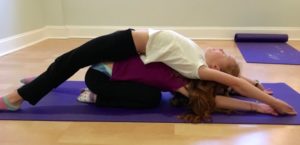
Children are born with the need and desire to connect with those around them. As you watch a child develop from birth to age 4, she will begin to interact with the world with smiles, then play with caregivers, model behavior, parallel play, participate in group activities, and at age 4 develop friendships and engage in dramatic play. 8-10 year olds are learning how to relate to peers, adjust to social rules and change from free play to more elaborately structured interactions and expectations. Preteens and teens are learning who and where they are in the world, and friends and their group of friends are vital.
Yoga in Sanskrit means union/connection, and partner poses do exactly that. It takes trust to create these poses 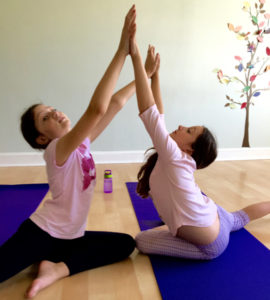 together and is a great communication builder, both nonverbal and verbal. Working with a partner builds teamwork, and cooperation skills. Partner poses also challenge balance, strength and stability. Therefore, meeting physical and social/emotional developmental needs of children of all ages: connection, acceptance, confidence, increased strength and stability and increased self-esteem. In a yoga class they create a sense of community.
together and is a great communication builder, both nonverbal and verbal. Working with a partner builds teamwork, and cooperation skills. Partner poses also challenge balance, strength and stability. Therefore, meeting physical and social/emotional developmental needs of children of all ages: connection, acceptance, confidence, increased strength and stability and increased self-esteem. In a yoga class they create a sense of community.
Performing partner poses with your preschooler and kindergartener is a great opportunity for a parent and child to connect. It is a fun way to get your child started in yoga, especially addressing her interests at this age of imaginative play.
Double Bow is a favorite in my Family Yoga class. It is great strength work for the parent (bottom partner), who may become a flying carpet, superwoman, or a beautiful bird. The parent lies on her stomach, then the child lies on her parent’s back. Both partners bend their knees and reach back for the outside of their feet. Bottom partner lifts chest and legs off the ground and top partner goes along for the ride. Puppy Straddle Hug is another partner pose suited for the imagination. Sitting, face each other and spread legs apart in a wide V, feet flexed. The child places her feet on the insides of her parent’s ankles. Fold forward from the waist, hold each other’s upper arms or shoulders and let your heads gently come together.
Children this age enjoy copying you, and doing yoga poses beside you or even under you.
When you practice yoga with your child, you can’t help but deepen the bond that exists between the two of you.
–Leela Lipscombe, co-owner of the Body*Mind*Spirit yoga center in Charlottesville, VA.
My 8-10 year old yogis are all about being loud and having fun in yoga class. They are enthusiastic about trying partner poses, however only want to buddy with their friends. I often start with a group pose such as a Staircase or Group Sunflower. There are so many partner poses that are developmentally appropriate for this age group and that the kids love.
Lizard on a Rock is a favorite of all ages. One person becomes the rock, in child’s pose. Lizard partner gently sits on the edge of the lowest part of the back and rolls back into a backbend bringing arms overhead reaching for the wrists of the lizard. Lizard relaxes and suns himself on the rock. Most children need help rolling back and balancing on their partner’s back as little spines can be bony. There is always lots of laughter. By now kids are mixing around among partners, eager to try other poses. They are learning to connect, becoming more confident. Double Boat Pose is another favorite of all ages. The yogis sit across from each other, hold hands and place the soles of their feet together with knees slightly bent. Lean back, lift and extend legs straight up between the arms.
You can search on Pinterest and your favorite search engine for partner poses for all ages. The following are a few more that are favorites for my young elementary yogis:
- Elevator
- Lawn Chair
- Double Tree
- Warrior Friends
To dramatize a story or a discussion, 2 yogis will often intertwine 2 poses to make a new one, or do the same pose at the same time.
The older elementary yogis love the challenge of Double Dog, and have even mastered Triple Dog. They are connecting with other yoga students in class and comfortably partnering with each other for the next challenge. A few other partner poses I include in my 8-10 year old yoga classes:
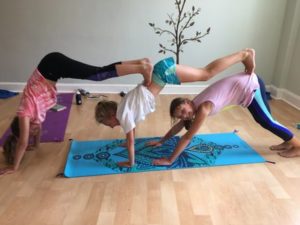
- Double Dancer
- Double Standing Forward Bend
- Revolved Chair
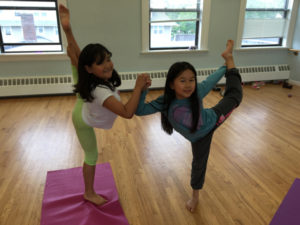
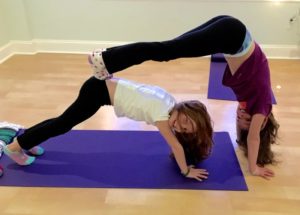
Networking, gaining self-confidence, belonging and being challenged are important developmental issues for preteens and teens. Including Partner Poses in their yoga classes addresses all of these. They are eagerly anticipated in my preteen yoga classes, and the kids challenge me to come up with more. I often begin the yoga class with a networking activity such as a yarn web to begin the process of connecting. Partner poses are often included in a vinyasa flow, such as Double Tree, Double Dancer, Double Dog, or Back-Bending Cobra. Usually we have a partner pose session near the end of class when all are warmed up, relaxed, and ready to be challenged and have fun. The preteens ask for new partner challenges weekly. Below are a few of the poses they have achieved and enjoyed.:
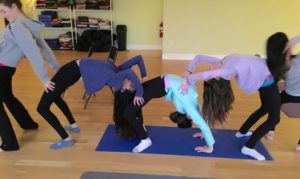
- Child’s and Reclined Hero Pose
- Assisted Bow Pose
- Shoulder Stand on Bridge Pose
- Double Plank
- Partner Camel
- Sideways Warrior
- Extended (to shoulder) Forward Leg Pose
- Forward Bend and Plank
- Assisted Cobra with Chair
- Lifted Plank
- Supported Wheel Pose
- Triple Dog
- Triple Wheel Pose
- Group Table
I was very impressed by the team work, problem solving, kindness and joy expressed by the preteens in one of my yoga classes as they were given the challenge of “How to Be a Table”. The directions called for 4 people and 4 chairs. Their challenges: they were varied heights by a foot or so, there were 5 of them, and they collapsed when the chairs were removed. They wanted to include everyone in this pose and try it without chairs. Success! They connected, they belonged, they gained self-confidence. The room echoed with laughter.
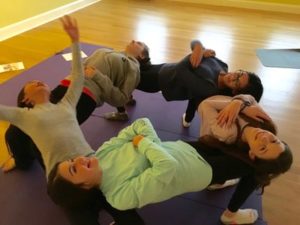
Connection is a basic human need. Partner Poses, practiced by all ages, can fulfill this need. Practice at home with your children or your partner. Include a Family Yoga class in your schedule. Sign your children up for yoga classes.
Giving children the tools to balance their emotions, calm nerves and develop a sense of self is THE way to ensure that our next generation does not end up being disconnected from each other and the planet.
-Joanne Moules, “5 Tips for Doing Yoga With Kids”
Leave a Reply